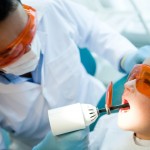
Fissure sealants have been in use since the 1960s and previous reviews have shown them to be effective in reducing caries. This review is the 4th update of the Cochrane review by Ahovuo-Saloranta et al and includes studies up November 2012. The main aim of the review was to compare the effects of different types of fissure sealants in preventing caries in permanent teeth in children and adolescents.
A wide range of databases were searched (Cochrane Oral Health Group’s Trials Register, the Cochrane Central Register of Controlled Trials (CENTRAL), Medline Embase SCISEARCH, CAplus, INSPEC, NTIS, PASCAL, and DARE, NHSEED and HTA) without language or publication restrictions. ClinicalTrials.gov was searched for ongoing trials. Randomised or quasi-randomised controlled trials of at least 12 months duration comparing sealants with no sealant or different type of sealant in children and adolescents under 20 years of age were included. First generation sealants were excluded.
- 34 trials involving 6529 patients aged from 5 to 16 years were included.
- 12 trials (2575 participants) compared sealant no sealant (9 split mouth,3 parallel)
- 21 trials (3202 participants) compared one type of sealant compared with another
- 1 trial evaluated two different types of sealant and no sealant (752 participants).
- Trials rarely reported the background exposure to fluoride of the trial participants or the baseline caries prevalence.
- For the main outcome, resin-based sealant compared with no sealant at 2 years follow-up the quality of the evidence was considered moderate using GRADE methodology. The odds ratio (OR) is 0.12, 95% confidence interval (CI) 0.07 to 0.19.
- For example if you assumed that:-
- 40% of the control tooth surfaces decayed during 2 years of follow-up (400 carious teeth per 1000), then applying a resin-based sealant will reduce the proportion of the carious surfaces to 6.25% (95% CI 3.84% to 9.63%)
- 70% of the control tooth surfaces decayed during 2 years of follow-up (700 carious teeth per 1000), then applying a resin-based sealant will reduce the proportion of the carious surfaces to 18.92% (95% CI 12.28% to 27.18%).
- There is insufficient evidence to make any conclusions about whether glass ionomer sealants, prevent caries compared to no sealant at 24-month follow-up
- The relative effectiveness of different types of sealants remained inconclusive.
- Only two trials mentioned adverse effects and stated that no adverse effects were reported by participants.
The authors concluded
The application of sealants is a recommended procedure to prevent or control caries. Sealing the occlusal surfaces of permanent molars in children and adolescents reduces caries up to 48 months when compared to no sealant, after longer follow-up the quantity and quality of the evidence is reduced. The review revealed that sealants are effective in high-risk children but information on the magnitude of the benefit of sealing in other conditions is scarce. The relative effectiveness of different types of sealants has yet to be established.
Comment
While the review focuses on caries reduction effectiveness is related to the retention of the sealant and this is noted in the discussion, this indicates that in the studies comparing sealant with a control without sealant resin sealants were retained completely on average in 80% of cases
Links
Ahovuo-Saloranta A, Forss H, Walsh T, Hiiri A, Nordblad A, Mäkelä M, Worthington HV. Sealants for preventing dental decay in the permanent teeth. Cochrane Database of Systematic Reviews 2013, Issue 3. Art. No.: CD001830. DOI: 10.1002/14651858.CD001830.pub4.

[…] Dental Elf – April 8th 2013 – Review recommends fissure sealants for caries prevention i… […]
[…] Dental Elf 8th Apr 2013 – Review recommends fissure sealants for caries prevention in permanen… […]
[…] Dental Elf – 8th Apr 2013 – Review recommends fissure sealants for caries prevention in perm… […]
[…] Dental Elf – 8th Apr 2013 – Review recommends fissure sealants for caries prevention in pe… […]
[…] Review recommends fissure sealants for caries prevention in permanent teeth […]